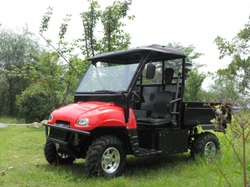|
The coolant in your vehicle should be changed if you haven’t changed it in a year or in the past 20,000 miles; if your vehicle constantly loses liquid in the system and overheats easily; or if you’ve frequently added plain water to your cooling system to the point where it’s probably lowered the proportion of coolant to less than half the required 50/50 mixture. Even if none of the above is true, your coolant may still need a change.  Use a coolant protection level tester. Use a coolant protection level tester. Coolant testers like the one shown here are cheap and easy to use; they tell you whether the protection level of the coolant in your system is adequate. They usually involve opening the pressure cap and drawing a little liquid out of the system and into the tester. Little balls or a float in the tester tell you whether you need to add coolant (the instructions are on the package). (While you’re at it, you also can check the liquid in the tester for rust.) You can buy test strips that do the same thing as a tester by changing color. Here are a couple of things to consider when deciding whether a change is in order: The quality of the liquid in the system: Unscrew the pressure cap and look at the liquid inside the reservoir or radiator, depending on the type of system you have. Coolant can be green, greenish yellow, orange, red, or blue, but is the liquid clear, or is stuff floating around in it? Does it look rusty? (Don’t mistake red coolant for rust; rusty water has particles floating around in it.) How frequently you’ve added water and how much you’ve added: If you’ve been adding plain water every couple of days or weeks, your coolant protection level is probably low. What kind of climate you live in: If the temperature gets very cold in the winter or very hot in the summer, be sure that you have enough coolant/antifreeze in your system before extreme weather sets in. In most areas, a 50/50 solution is recommended for year-round use. If the weather turns extremely cold, you can add a slightly higher proportion of antifreeze without hurting your cooling system. Never exceed a 70/30 mixture of antifreeze to water. Freeze protection actually worsens with too much antifreeze and not enough water. If the weather is extremely hot, exceeding the recommended proportions of water and coolant won’t help prevent your vehicle from overheating; it may actually cause it to overheat more rapidly. How often you use your car’s air conditioner: Although the air conditioner does a fine job of keeping the interior of the car cool, it raises the temperature of your engine. So be sure you have a good mix of coolant and water during the warm months when you use your air conditioner most often. If the level of coolant is very low or its protection level is weak, it may be a good time to flush your cooling system. If you don’t flush the system, check the level at the end of autumn to see whether you should flush it before the cold weather sets in.
0 Comments
Leave a Reply. |
Categories
All
Archives
December 2019
|


 RSS Feed
RSS Feed
